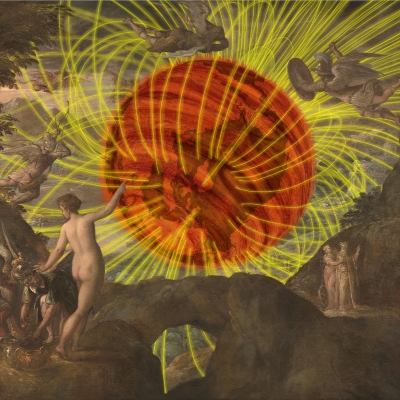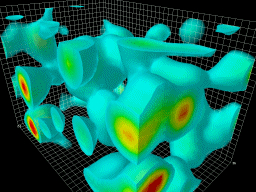

When I was little, I tried to make an electromagnet by winding a thin wire around a nail and connecting it to a battery. I must have seen this on Mr. Wizard’s World. But instead of magically picking up paper clips, it just got hot and wasted the battery. What I didn’t understand is that the wire must be insulated, not bare metal: instead of flowing around the nail in many circular loops, the electric current flowed through the whole thing as a bumpy metal blob.
This fact that circulating electric currents produce magnetic fields can be seen everywhere in nature. Electromagnets, whether they flip bits in a hard drive or cars in a junkyard, are essentially just (insulated) wires wound around nails. Neutron stars spin faster and faster as they collapse, generating the strongest magnetic fields known in the universe. Elementary particles such as electrons are haloed by tiny magnetic fields due to their intrinsic spin, a kind of internal rotation they can never stop. Even refrigerator magnets are not as stationary as they seem: their magnetic fields are due to a partial alignment of electron spins.
Sometimes, though, the flow can be so turbulent and complicated that its dynamics are a mystery. The underlying equations are known, but even supercomputers are not powerful enough to determine the implications of those equations. Only simplified versions of these systems can be calculated, so the predictions don’t exactly match the real systems in all their messy glory. The two examples I have in mind are a proton’s magnetic field and the Earth’s.
Protons
A proton is more of a process than a particle. We usually say that a proton is made of three quarks, but it is mostly made of the motions of quarks. Unlike anything in our everyday experience, a proton is extremely relativistic: distortions in time and space are normal for its quarks. In addition, they are completely quantum mechanical: overlapping realities are a regular part of a quark’s world. And if that weren’t enough, the force holding them together is weird: the particles that draw quarks toward each other are themselves attracted by that force. Each of these gluons produce more and more gluons, a run-away effect similar to the gravitational field of a black hole. Yet protons are everywhere— all of the matter that we see, feel, walk on, and eat is made of protons.
Energy and mass are interchangeable, but the amount of energy in everyday physical systems like cars and bowling balls is insignificant compared to the mass involved. In extremely relativistic systems like a proton, the reverse is true. The mass of the three quarks in a proton account for less than 1% of its total mass-plus-energy. This energy has heft: it is the reason that protons (and consequently all known matter) is heavy, because the Earth’s gravity pulls on the energy of the quark’s motion just as it would pull on mass. If a bowling ball were rolling fast enough, it too would get heavier due to its motion.
When enough energy is available, a particle and its antimatter counterpart can spring out of empty space— or more precisely, out of the energy corresponding to the two new particles’ masses. Since there’s so much energy in a proton, quark-antiquark pairs are appearing all the time. They quickly annihilate with other antiquarks and quarks, so while a proton may have more than the canonical “three quarks,” the total number of quarks minus the total number of antiquarks is always three. The quantum nature of the proton makes this picture even fuzzier: at any given moment, there’s one quark-antiquark pair, a hundred quark-antiquark pairs, and any other number, all overlapping each other in simultaneous quantum realities. A proton is not just a froth of quarks and antiquarks appearing and disappearing at random— it’s a little multiverse of all possible froths.
That much is well-understood. The mysterious part involves the strange force law that holds the quarks together. Electromagnetism, the force that we are familiar with in everyday life (it’s responsible for everything that sticks, tugs, or pushes— everything but gravity) is much simpler. In electromagnetism, positive and negative charges attract and same-sign charges repel. The quark force, called quantum chromodynamics (QCD), has three different kinds of charges in place of electromagnetism’s one. The quark charges are metaphorically called red, green, and blue, and their opposites are cyan, magenta, and yellow (or sometimes just antired, antigreen, and antiblue, by physicists who don’t remember the color wheel from art class).

Derek Leinweber’s simulations of QCD (see more).
Also unlike the simple positive and negative charges of electromagnetism, quarks are changing their color-charge all the time. When a red quark meets a blue quark, they attract each other, but they can also swap colors: the red turns blue and the blue turns red. That is because the force of attraction between them is also colored: a cyan-yellow gluon is emitted by the first quark and absorbed by the other. Since these gluons have color charge, they themselves are attracted to quarks and to other gluons. The result is a real mess: quarks attracting each other, which creates gluons that attract quarks and other gluons, the gluons spawned by that attraction, and all the quark-antiquark pairs that the energy of this attraction produces. Every combination of this is happening all the time, at the same time in concurrent quantum realities.
That can be simulated in a computer, but the calculation takes a long time and is impractical without some approximations.
It is perhaps not surprising that some features of the humble proton are still a mystery. In particular, no one really understands where a proton’s magnetic field comes from: each proton has one half-unit of spin, which produces a magnetic field of 0.2 Tesla at a distance of 25 picometers, where the electron sits in a typical atom. (That’s about the strength of a refrigerator magnet.) Naively, this +1/2 might have come from the three quarks, which can have +1/2 or -1/2 units of spin each: (+1/2) + (+1/2) + (-1/2) = (+1/2). That would have made sense, since the spins of the quark-antiquark pairs should cancel each other on average, as would the +1 and -1 spins of the gluons. But a 1987 experiment (the European Muon Collaboration) showed that this simply isn’t true. Only about a third of the proton’s spin is due to these quarks. It came as such a surprise that it was called the proton spin crisis— nobody knows where the proton’s magnetic field comes from.
After a quarter-century of increasingly sophisticated experiments and mathematical approximations, the final answer is still unknown. Two contenders have been nearly eliminated: it’s most likely not the intrinsic spins of the quark-antiquark pairs or the gluons. What’s left is the complex motion of all these parts— perhaps a proton generates its magnetic field the same way that an electromagnet does, with the circulating motion of electric currents from the orbiting quarks (quarks are electrically charged). Or perhaps there’s something more fundamental to be learned.
Planets
The Earth is enormously different from a proton. Its parts move slowly enough that relativity is not a factor, and they are large enough that quantum mechanics is irrelevant. Apart from the heat generated by radioactive decays, the only relevant forces are gravity and good old electromagnetism. Yet the source of the Earth’s magnetic field is as mysterious as that of the proton, and for the same reason: the underlying equations are too complicated to solve.
Not all planets have a magnetic field as strong as the Earth’s. Mars, for instance, has no measurable magnetic field. The Earth’s field traps charged particles radiated by the sun, keeping them from reaching us, but these particles irradiate the surface of Mars. Thus our planet’s magnetic field is one of the reasons this is such a nice place to live.
The Earth’s field is also slipping away: it has been steadily declining since measurements began in 1838, and is now about 10% weaker than that first measurement. Magnetized imprints in rocks of different strata show that our planet’s field completely reverses every million years or so— the last field-flip was in 780,000 B.C. During a reversal, the solar radiation might cause cancers and fry electronics, so it’s worthwhile to try to forecast it.
However, the exact nature of Earth’s magnetic field has so far evaded prediction. We do know a few basic facts. It doesn’t work like a refrigerator magnet, iron with a frozen-in magnetization. Hot iron (above the “Curie Temperature”) can’t hold onto a magnetic field, and most of the iron in the Earth’s core is way too hot. The field is most likely generated by the motion of charged magma flowing in the outer core (the inner core is solid). Moving charges create magnetic fields, but for the Earth’s field to be as strong as it is, the mere fact that the Earth rotates once a day is not enough.
Magnetic fields cause charges to flow, and sometimes this results in a self-reinforcing feedback of fields making current and current making fields. The process, called a magnetic dynamo, must be seeded by some initial magnetic field and fed energy while the magnetic field grows. Dynamos are surprisingly ubiquitous in the universe— most galaxies, stars, and large planets have dynamically generated magnetic fields— but they are also fragile and hard to predict. Rocks on Mars show that it once had a strong magnetic field, which somehow sputtered out.
Dynamos are inherently complex, as they are essentially a form of organized turbulence. You have probably seen many examples of turbulence: think of a stream of water flowing around rocks. The water churns and swirls in hair-like patterns, with vorticies and eddy currents spinning the wrong way, slowing down the main flow. A dynamo is what happens when turbulent flow organizes into a self-enhancing system, with eddy currents that strengthen and maintain the overall magnetic field. The wrong turbulence can snuff it out.
Computers can simulate this kind of process, but with limitations. All of the calculations must be split into a grid of pixels because a computer is inherently discrete. Eddy current loops smaller than a pixel cannot be simulated: the computer’s model is therefore an approximation based on the assumption that vorticies smaller than a pixel are irrelevant. If large vorticies and small vorticies are both relevant, then it could take the computer years or more to produce a result. This is true of the Earth’s dynamo.
U. Maryland’s artificial dynamo (read more).
Instead, the problem is being solved experimentally. Groups of physicists are building model Earths to study the dynamics of magma flow and magnetic fields. They don’t use real lava because the scale would be wrong: the size of the eddy currents in the experiment must be in proportion to the eddy currents in the Earth. Since the model Earths are all less than 10 feet tall, the eddy currents in the fluid of the experiment must be 20 thousand times smaller than the ones in real magma. Liquid sodium has the right sized eddy currents, so most of these experiments are filled with that. Sodium is the metal you may remember from a chemistry class demonstration: a tiny amount of it explodes on contact with water. It might have been easier to use lava.
In the Giant’s Fingernail
I don’t remember who, but someone told me once that the Earth and the Solar System are just atoms and molecules in a giant’s fingernail, and that the giant’s planet is an atom in an even bigger universe. Our atoms are supposedly little planets, too, with little people on them: it’s a self-repeating world, all the way up and all the way down.
While that would be pretty cool, it’s not true. Atoms are very different from planets, and they obey different laws. However, some things defy the tyranny of scale. Magnetic fields are produced by rotation, no matter how large or small. And on nearly every scale, we can find self-reinforcing processes so complex that they have so far defeated our best attempts to understand them.